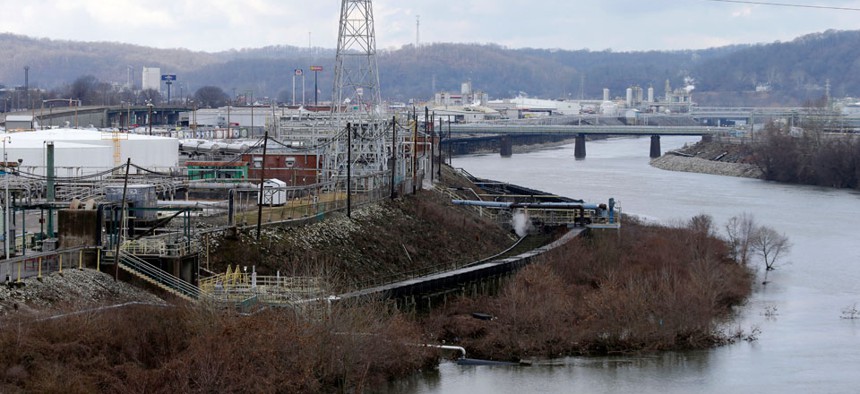West Virginia Water Contamination Prompts Federal Response
U.S. Chemical Safety Board investigates accident as lawmakers, environmentalists call for answers.
The dangerous chemical plume beginning on Jan. 9 that spoiled the water supply for 300,000 people in West Virginia has prompted an array of responses in Washington, including rushing emergency supplies to the state, a field visit from specialized investigators and lawmakers calling for hearings on environmental regulations.
As officials told citizens Tuesday in the Charleston, West Va. area that the water was safe again, multiple calls were heard for probes into state and federal regulatory practices that failed to prevent the coal company Freedom Industries from accidentally releasing the chemical 4-methylcyclohexane methanol from a storage tank into the Elk River.
President Obama declared the nine affected counties a disaster area on Jan. 10, and the Federal Emergency Management Agency dispatched water trucks and three million liters of bottled water from distribution centers near Charleston, as well as from Maryland and Philadelphia.
On Jan. 13, an investigative team from the U.S. Chemical Safety Board, an independent, nonregulatory agency, arrived in Charleston. “This incident continues to impact the people of West Virginia,” said CSB Chairman Rafael Moure-Eraso. “Our goal is to find out what happened to allow a leak of such magnitude to occur and to ensure that the proper safeguards are in place to prevent a similar incident from occurring.”
Sen. Jay Rockefeller, D-W.Va., on Jan. 14 wrote to the heads of the Environmental Protection Agency and the Centers for Disease Control and Prevention requesting a comprehensive study into the long-term public health risks associated with crude 4-methylcyclohexane methanol.
“I am making this request of two separate agencies with the goal that no stone will go unturned, and no jurisdictional confusion will leave any key question unanswered,” wrote Rockefeller, who urged Senate colleagues to boost fiscal 2014 funding for the U.S. Chemical Board. A 2013 report from the nonprofit Center for Public Integrity found that the Chemical Board is understaffed and underfunded to the point where its investigations remain open for too long.
Sens. Joe Manchin, D-W.Va., and Barbara Boxer, D-Calif., chairwoman of the Environment and Public Works Committee, called for hearings, as did Rep. Henry A. Waxman, D-Calif., ranking member of the House Energy and Commerce Committee.
EPA gave <em>Government Executive</em> a statement on Wednesday saying, “We continue to work closely with other federal and state agencies in West Virginia as they begin implementing a plan for getting the water system back on-line. As those efforts are already underway, EPA is also examining state and federal response authorities associated with the incident to determine next steps and the environmental laws and regulations applicable to the facility.”
State and national environmental groups said the disaster demonstrates the need for stronger public protections through regulation. “The West Virginia chemical spill that has poisoned the water supply for hundreds of thousands of people is the latest in a series of environmental and safety disasters related to shortcomings in federal and state oversight that have often been driven by vociferous, industry-funded anti-regulatory campaigns,” said the Coalition for Sensible Safeguards in a statement. “It’s time to reform our chemical safety laws -- both at the state and federal levels -- to prevent the next dangerous accident or spill.”
Rick Hind, legislative director for Greenpeace and a member of the nonprofit Coalition to Prevent Chemical Disasters, said the spill “exposes a host of fatal safety gaps in our regulatory program” that is built around the Emergency Planning and Community Right-to-Know Act, Safe Drinking Water Act, Clean Water Act, Clean Air Act and the Toxic Substances Control Act.
“In many cases, the Obama administration has authority to close these gaps,” Hind said. “In other cases, especially TSCA, Congress will need to overhaul existing laws” to replace the current “patchwork” of risk-management systems, he said. “Otherwise we will continue to gamble with the lives of innocent people and businesses who bear the cost of inherently dangerous chemicals and/or processes.”




